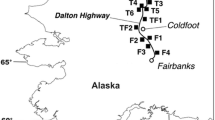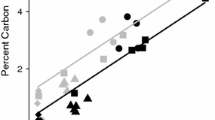Abstract
In Northern Alaska (AK), large variation in biogeochemical cycling exists among landscapes underlain by different aged geologic substrates deposited throughout the Pleistocene. Younger, less weathered landscapes have higher pH (6.5 vs. 4.5), ten-fold higher exchangeable cation concentrations, and slower rates of microbial activity than older, more weathered landscapes. To tease apart the effects of polyvalent cations vs. pH on microbial activity and organic matter solubility and stabilization, we conducted a soil incubation experiment. We collected soils near Toolik Lake, Alaska from replicated sites along a chronosequence of landscape ages ranging from 11,000 to 4.8 million years since glaciation and manipulated soil pH and calcium (Ca, the dominant polyvalent cation across all landscape ages) using a factorial experimental design. As expected, microbial respiration was inhibited by high Ca concentrations at both pH 6.5 and 4.5. In contrast, soils with circumneutral pH (but similar Ca concentrations) exhibited higher rates of microbial respiration than soils with acidic pH, opposite of in situ patterns. Manipulated soils with acidic (4.5) pH (but similar Ca concentrations) exhibited higher cumulative dissolved organic nitrogen (DON) in leachates than soils with circumneutral (6.5) pH, similar to in situ patterns of leaching among landscape ages, but there was no consistent effect of pH on dissolved organic carbon (DOC) in leachates across landscape ages. Increasing Ca concentration inhibited cumulative DOC in leachates at circumneutral pH as expected, but had no effect on DOC or DON in leachates at acidic pH. Our results indicate that both polyvalent cation concentration and pH likely influence microbial activity in tundra soils, suggesting that heterogeneity in geochemical factors associated with landscape age should be considered in models of tundra biogeochemistry.





Similar content being viewed by others
References
Andersson S, Nilsson SI, Saetre P (2000) Leaching of dissolved organic carbon (DOC) and dissolved organic nitrogen (DON) in mor humus as affected by temperature and pH. Soil Biol Biochem 32:1–10
Beck T, Joergensen G, Kandeler E, Makeschin E, Oberholzer HR, Scheu S (1997) An inter-laboratory comparison of ten different ways of measuring soil microbial biomass C. Soil Biol Biochem 29:1023–1032
Bockheim JG, Walker DA, Everett LR, Nelson FE, Shiklomanov NI (1998) Soils and cryoturbation in moist nonacidic and acidic tundra in the Kuparuk River Basin, Arctic Alaska, USA. Arct Alp Res 30:166–174
Brookes PC, Landman A, Pruden G, Jenkinson DS (1985) Chloroform fumigation and the release of soil nitrogen: a rapid direct extraction method to measure microbial biomass nitrogen in soil. Soil Biol Biochem 17:837–842
Callaghan TV, Jonasson S (1995) Implications for changes in Arctic plant biodiversity from environmental manipulation experiments. In: Lange OL, Mooney HA (eds) Arctic and Alpine biodiversity: patterns causes and ecosystem consequences. Ecological Studies, vol 113. Springer Berlin
Chorover J, Amistadi MK, Chadwick OA (2004) Surface charge evolution of mineral–organic complexes during pedogenesis in Hawaiian basalt. Geochemica et Cosmochimica Acta 68:4859–4876. doi:10.1016/j.gca.2004.06.005
Epstein HE, Calef MP, Walker MD, Chapin FS, Starfield AM (2004) Detecting changes in arctic tundra plant communities in response to warming over decadal time scales. Glob Change Biol 10:1325–1334. doi:10.1111/j.1365-2486.2004.00810.x
Frey KE, Smith LC (2005) Amplified carbon release from vast West Siberian peatlands by 2100. Geophys Res Lett 32(9):L09401. doi:10.1029/2004GL022025
Frey KE, Siegel DI, Smith LC (2007) Geochemistry of wet Siberian streams and their potential response to permafrost degradation. Water Resour Res 43:W03406. doi:10.1029/2006WR004902
Hobbie SE (1996) Temperature and plant species control over litter decomposition in Alaskan tundra. Ecol Monogr 66:503–522
Hobbie SE, Gough L (2002) Foliar and soil nutrients in tundra on glacial landscapes of contrasting ages in northern Alaska. Oecologia 131:453–462. doi:10.1007/s00442-002-0892-x
Hobbie SE, Gough L (2004) Litter decomposition in moist acidic and non-acidic tundra with different glacial histories. Oecologia 140:113–124. doi:10.1007/s00442-004-1556-9
Hobbie SE, Miley TA, Weiss MS (2002) Carbon and nitrogen cycling in soils from acidic and nonacidic tundra with different glacial histories in Northern Alaska. Ecosystems 5:761–774. doi:10.1007/s10021-002-0185-6
Kaiser K (1998) Fractionation of dissolved organic matter affected by polyvalent metal cations. Org Geochem 28:849–854
Kaiser K, Guggenberger G (2000) The role of DOM sorption to mineral surfaces in the preservation of organic matter in soils. Org Geochem 31:711–725
Kaiser K, Guggenberger G (2003) Mineral surfaces and soil organic matter. Eur J Soil Sci 54:219–236
Kaiser K, Guggenberger G (2005) Storm flow flushing in a structured soil changes the composition of dissolved organic matter leached into the subsoil. Geoderma 127:177–187. doi:10.1016/j.geoderma.2004.12.009
Kaiser K, Guggenberger G, Haumaier L, Zech W (2002) The composition of dissolved organic matter in forest soil solutions: changes induced by seasons and passage through the mineral soil. Org Geochem 33:307–318
Kalbitz K, Solinger S, Park JH, Michalzik B, Matzner E (2000) Controls on the dynamics of dissolved organic matter in soils: a review. Soil Sci 165:277–304
Kawahigashi M, Kaiser K, Kalbitz K, Rodionov A, Guggenberger G (2004) Dissolved organic matter in small streams along a gradient from discontinuous to continuous permafrost. Glob Change Biol 10:1576–1586. doi:10.1111/j.1365-2486.2004.00827.x
Kipton H, Powell J, Town RM (1992) Solubility and fractionation of humic acid: effect of pH and ionic medium. Anal Chim Acta 267:47–54
Lilienfein J, Qualls RG, Uselman SM, Bridgham SD (2004) Adsorption of dissolved organic carbon and nitrogen in soils of a weathering chronosequence. Soil Sci Soc Am J 68:292–305
Lofts S, Woof C, Tipping E, Clarke N, Mulder J (2001) Modelling pH buffering and aluminium solubility in European forest soils. Eur J Soil Sci 52:189–204
Mack MC, Schuur EAG, Bret-Harte MS, Shaver GR, Chapin FS (2004) Ecosystem carbon storage in arctic tundra reduced by long-term nutrient fertilization. Nature 431:440–443. doi:10.1038/nature02887
Malmer N, Johansson T, Olsrud M, Christensen TR (2005) Vegetation, climatic changes and net carbon sequestration in a North-Scandinavian subarctic mire over 30 years. Glob Change Biol 11:1895–1909. doi:10.1111/j.1365-2486.2005.01042.x
Meier M, Chin Y-P, Maurice PA (2004) Variations in the composition and adsorption behavior of dissolved organic matter at a small, forested watershed. Biogeochemistry 67:39–56
Michalzik B, Kalbitz K, Park JH, Solinger S, Matzner E (2001) Fluxes and concentrations of dissolved organic carbon and nitrogen—a synthesis for temperate forests. Biogeochemistry 52:173–205
Monroe JS, Bockheim JG (2001) Soil development in low-arctic tundra of the Northern Brooks Range, Alaska, USA. Arct Antarct Alp Res 33:78–87
Moore TR, Turunen J (2004) Carbon accumulation and storage in mineral subsoil beneath peat. Soil Sci Soc Am J 68:690–696
Nadelhoffer KJ, Giblin AE, Shaver GR, Laundre JA (1991) Effects of temperature and substrate quality on element mineralization in six Arctic soils. Ecology 72:242–253
Nilsson SI, Andersson S, Valeur I, Persson T, Bergholm J, Wiren A (2001) Influence of dolomite lime on leaching and storage of C, N and S in a Spodosol under Norway spruce (Picea abies (L.) Karst.). For Ecol Manag 146:55–73
Oades JM (1988) The retention of organic matter in soils. Biogeochemistry 5:35–70
Oste LA, Temminghoff EJM, Van Riemsdijk WH (2002) Solid-solution partitioning of organic matter in soils as influenced by an increase in pH or Ca concentration. Environ Sci Technol 36:208–214. doi:10.1021/es0100571
Ping CL, Bockheim JG, Kimble JM, Michaelson GJ, Walker DA (1998) Characteristics of cryogenic soils along a latitudinal transect in Arctic Alaska. J Geophys Res 103:28917–28928
Qualls, RG, Haines BL, Swank WT, Tyler SW (2002) Retention of soluble organic nutrients by a forested ecosystem. Biogeochemistry 61(2):135–171
Selmants PC, Hart SC (2008) Substrate age and tree islands influence carbon and nitrogen dynamics across a retrogressive semiarid chronosequence. Glob Biogeochem Cycles 22(1):GB1021. doi:10.1021/es0100571
Shaver G, Chapin FS (1991) Production : biomass relationships and element cycling in contrasting arctic vegetation types. Ecol Monogr 61:1–31
Shaver GR, Jonasson S (1999) Response of Arctic ecosystems to climate change: results of long-term field experiments in Sweden and Alaska. Polar Res 18:245–252
Shaver GR, Giblin AE, Nadelhoffer KJ, Thieler KK, Downs MR, Laundre JA, Rastetter EB (2006) Carbon turnover in Alaskan tundra soils: effects of organic matter quality, temperature, moisture and fertilizer. J Ecol 94:740–753. doi:10.1111/j.1365-2745.2006.01139.x
Shen Y-H (1999) Sorption of natural dissolved organic matter on soil. Chemosphere 38:1505–1515
Solórzano L (1969) Determination of ammonia in natural waters by the phenolhypochlorite method. Limnol Oceanogr 14:799–801
Tipping E, Berggren D, Mulder J, Woof C (1995) Modelling the solid-solution distributions of protons, aluminium, base cations, and humic substances in acid soils. Eur J Soil Sci 46:77–94
van Wijk MT, Clemmensen KE, Shaver GR, Williams M, Callaghan TV, Chapin FS, Cornelissen JHC, Gough L, Hobbie SE, Jonasson S, Lee JA, Michelsen A, Press MC, Richardson SJ, Rueth H (2003) Long-term ecosystem level experiments at Toolik Lake, Alaska, and at Abisko, Northern Sweden: generalizations and differences in ecosystem and plant type responses to global change. Glob Change Biol 10:105–123
Whittinghill KA, Hobbie SE (2011) Effects of landscape age on soil organic matter processing in Northern Alaska. Soil Sci Soc Am J 75:907–917. doi:10.2136/sssaj2010.0318
Whittinghill KA, Finlay JC, Hobbie SE (in review) Decomposition of dissolved organic carbon across a hillslope chronosequence in the Kuparuk River region, Alaska
Wood ED, Armstrong FAJ, Richards FA (1967) Determination of nitrate in seawater by cadmium–copper reduction to nitrite. J Mar Biol Assoc UK 47:23–31
Worrall F, Burt TP, Adamson J (2006) The rate of and controls upon DOC loss in a peat catchment. J Hydrol 321:311–325. doi:10.1016/j.jhydrol.2005.08.019
You S-J, Yin Y, Allen HE (1999) Partitioning of organic matter in soils: effects of pH and water/soil ratio. Sci Total Environ 227:155–160
Yu Z, Kraus ECT, Dahlgren RA, Horwath WA, Zasoski RJ (2003) Mineral and dissolved organic nitrogen dynamics along a soil acidity-fertility gradient. Soil Sci Soc Am J 67(3):878–888
Acknowledgments
We thank Jim Cotner, Edward Rastetter, Gus Shaver, Joe McFadden, Paul Bloom, and Sandy Weisberg for their help and advice on this project and the Toolik Lake Field Station and Arctic Long Term Ecological Research program staff for logistical support. We would especially like to thank Megan Ogdahl and Jeff Eickhoff for their help with laboratory work. This material is based upon work supported by the Dayton-Wilkie Natural History Fund, the National Science Foundation Long-Term Ecological Research Program, and the National Science Foundation under the following grants: NSF DEB-008958, NSF OPP-0352897, and NSF-DEB 0423385.
Author information
Authors and Affiliations
Corresponding author
Rights and permissions
About this article
Cite this article
Whittinghill, K.A., Hobbie, S.E. Effects of pH and calcium on soil organic matter dynamics in Alaskan tundra. Biogeochemistry 111, 569–581 (2012). https://doi.org/10.1007/s10533-011-9688-6
Received:
Accepted:
Published:
Issue Date:
DOI: https://doi.org/10.1007/s10533-011-9688-6




